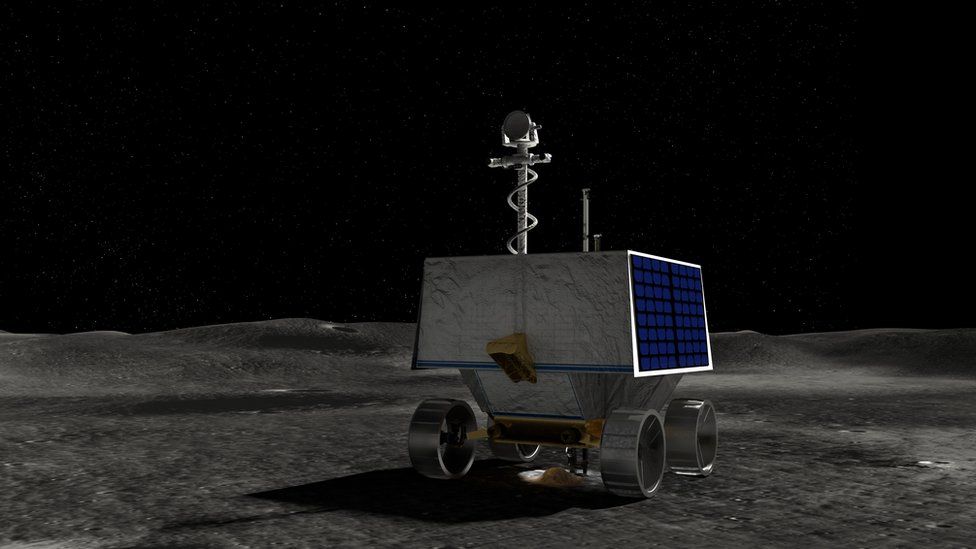
Nasa is sending a robotic rover to look for water-ice near a crater at the Moon’s South Pole.
In 2023, the golf truck estimated vehicle will land close to the western edge of Nobile Crater, a 73km-wide wretchedness that is forever in shadow. The Viper mission will uphold plans for human investigation of the Moon, on the grounds that the ice could be dug for use as drinking water and rocket fuel. Nasa needs to return space explorers to the lunar surface this decade. The space organization’s Artemis program will see the main lady and the primary minority land on the Moon. It could prepare for a drawn out human presence on Earth’s sole regular satellite.
Daniel Andrews, Viper’s task director from Nasa’s Ames Research Center in California, said the 2023 meanderer mission would assist researchers with seeing how simple or troublesome it would be for people to separate the water-ice. “In case assets are ample and available, it will truly change the idea of supporting people [on the Moon] and furthermore assist us with understanding the idea of how we recover those assets,” he clarified. Different lines of proof recommend there are billions of huge loads of lunar ice secured up polar pits that never see daylight and where temperatures plunge as low as – 223C (- 370F). Being in long-lasting shadow establishes the steady and freezing climate important to safeguard enormous frozen stores. Daniel Andrews said Viper – which represents Volatiles Investigating Polar Exploration Rover – could assist researchers with understanding key inquiries concerning the ice stores, for example, “where the ice is, the thing that focuses, how profound”. Anthony Colaprete, the lead project researcher on Viper, additionally based at Nasa Ames, said: “We’ve seen nothing very like what we will see when we show up at the South Pole. “The poles of the Moon are emotional, particularly the South Pole, where old effect bowls lifted mountains that bantam Mount Everest… it will be something really unbelievable.” Be that as it may, there are obstructions to investigating this new, ice-bearing locale. It’s trying to plan a wanderer ready to work in an area that is very cold around evening time and afterward warm during the day. The Sun is extremely low not too far off at the South Pole, and projects long, quick shadows. The outrageous swings in light and murkiness could make it harder for the meanderer to avoid risks and for the most part get where it should be. Specialists should cautiously design its course across the lunar scene with the goal that it can withdraw from the propelling dimness and keep up with power levels by keeping its sunlight based chargers highlighted the Sun. Yet, the robot should overcome the dull when it is directed to enter a few for all time shadowed holes. It’s the main Nasa wanderer to be outfitted with headlights, which will help as it looks to find and guide ice stores thought to be contained inside the totally dark hollows. Darlene Lim, the representative lead project researcher, said a group would work the meanderer from Earth in close ongoing. “The Viper science group will, thus, must be good to go to give essential, close constant contribution at extremely key minutes,” she clarified. The wanderer will hitch a ride on a lander worked by Astrobotic, a private spaceflight organization situated in Pittsburgh. The firm won a $199.5 million agreement to convey Viper to the lunar surface in June 2020, under a Nasa program called Commercial Lunar Payload Services (CLPS). CLPS is intended to help Artemis, however many likewise trust it could help launch a lunar economy, where business elements contend to give routine vehicle administrations to the lunar surface. In 2019, Astrobotic’s CEO John Thornton advised me: “I think what positions Astrobotic all around well to catch whatever takes off monetarily on the Moon is that we are the central assistance, we are the transportation framework. “We do have our conjectures on the thing we believe will be the following greatest thing on the Moon. What’s more, I believe that the mining will be perhaps the greatest one – digging explicitly for rocket fuel.” The water could be synthetically parted into hydrogen and oxygen, giving the fuels consumed in space apparatus motors. Re-fuelling vehicles at the Moon could cut down the expense of room travel and make a lunar station more moderate. A 2018 report proposed that rocket force could be delivered at an expense of $500 (£365) per kg on the lunar surface. That is multiple times less expensive than the $10,000 per kg extended expense of moving it from Earth to lunar circle. In the interim, arrangements for the main missions in the Artemis program are continuing apace. The Space Launch System (SLS) rocket for the first – uncrewed – Artemis mission is approaching full gathering at Nasa’s Kennedy Space Center dispatch complex in Florida. Specialists will stack the last leftover piece – the Orion spaceship – on the SLS in coming weeks. Recently, Nasa likewise finished welding the construction of the Orion case that will convey space explorers during the primary mission to arrive on the Moon since 1972.





































































































































































































































































































































































































































































































































































































































































































































RSS